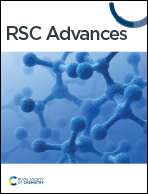An irreversible paper-based profluorescent nitroxide probe for the selective detection of ascorbic acid†
Abstract
Ascorbic acid (AA) or vitamin C plays multiple crucial roles, particularly as an antioxidant. This essentially biologically active molecule was selectively detected over other reductants by the synthesized profluorescent nitroxide probe ProN6 via a switch-on method. After either a hydrogen atom or single electron transfer from AA to nitroxide, the resulting diamagnetic hydroxylamine was rapidly cyclized to form a fluorescent O-acylalkoxyamine. This cyclization prevented the reoxidation of the corresponding hydroxylamine to the nitroxide, leading to a high precision of detection. A kinetic fluorescence study indicated that ProN6 exhibited higher reactivity than ProN7. Density functional theory (DFT) calculations indicated that the Gibbs free energy of the AA-induced cascade reductive lactonization of ProN6 was lower than that of ProN5 and ProN7. The designed probe achieved the sensitive and specific detection of AA with detection limits of 77.9 nM and 195.9 μM in solution and on paper, respectively. The utilization of the probe as a paper-based fluorescent sensor demonstrated the good accuracy of the quantitative analysis of AA in commercial supplements.



 Please wait while we load your content...
Please wait while we load your content...